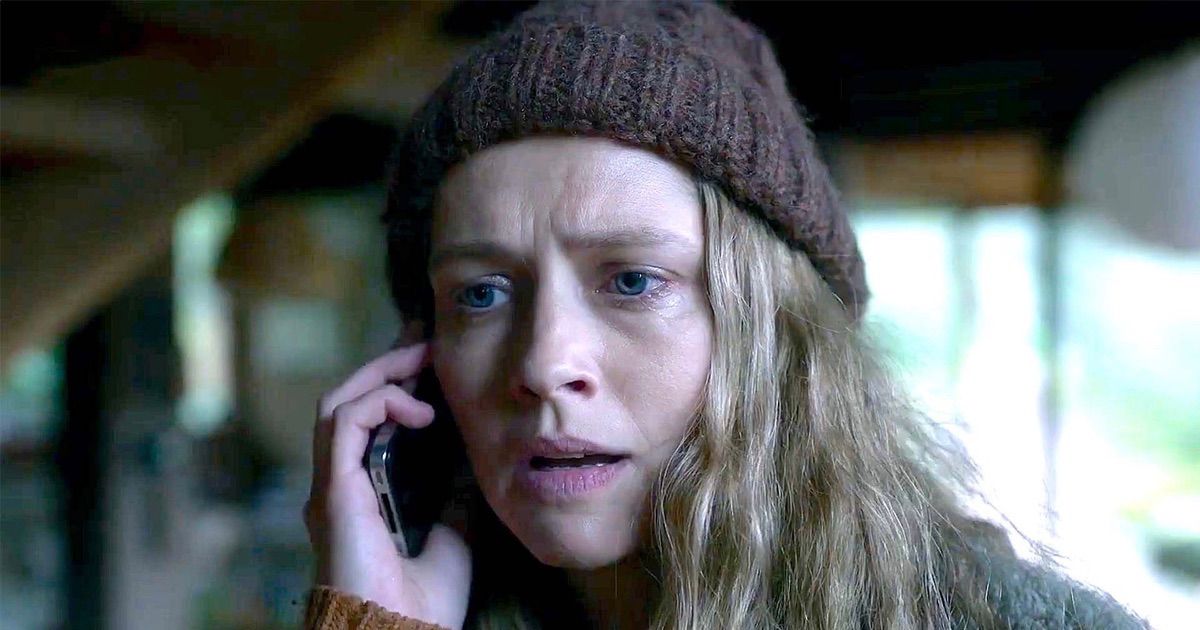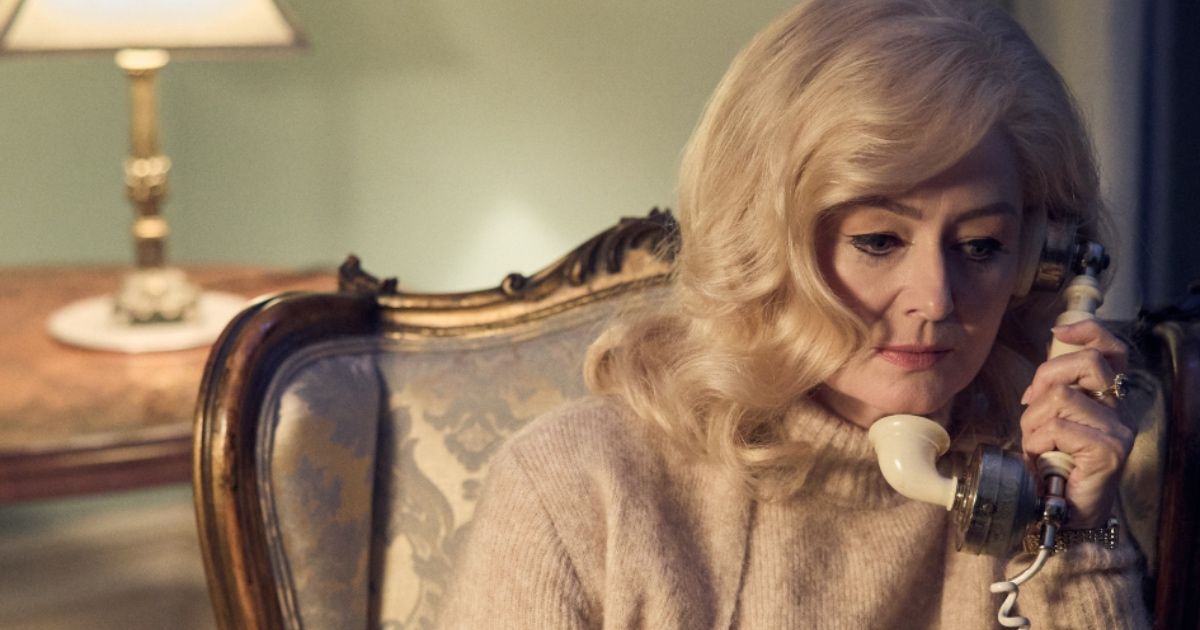“People can be cruel and kind at the same time. You will learn that.” The eerily poignant advice is a quote from Amy to Asha — from one kidnapped child to another — in The Clearing, an eight-part psychological thriller based on the bestselling crime thriller In the Clearing by author J.P. Pomare. The timely advice for survival also serves as a helpful disclaimer for viewers as a way to digest the twists and complexities in the spellbinding, terrifying, and completely unnerving Australian cult series. Inspired by real life events, The Clearing is certain to be a hit for fans of well-written dramas in the vein of The Handmaid’s Tale and Alias Grace.
Filmed in a fascinating, and at times mystifying but effective non-linear fashion, The Clearing is an emotional ride and psychological journey led by a woman who simultaneously confronts the demons of her past while fighting to impede the cult’s still ongoing kidnapping of innocent children. When will the nightmares of the past (and of the future) end? How do the past and the future overlap? By the end of the first episode, there is a gasp-worthy realization.
Stars of the series, Teresa Palmer (Discovery of Witches) and Miranda Otto (The Unusual Suspects) sat down with MovieWeb in an exclusive interview to discuss what led them to want to be a part of this dark and sophisticated series and why it is one to watch.
How Miranda Otto Got Into Character
Otto explained her reason for signing on to portray Adrienne, the icy leader of a cult where children are abducted from their loving homes, becoming (mostly) unyielding, dutiful, and loyal under her grip. They even willingly call her “Mother.”
“I’ve always been really fascinated by cults,” said Otto. “My auntie was actually in the Rajneesh when I was a kid, and I’ve read a number of books about that experience, and I’ve seen a lot of documentaries on cults […] So, I sort of came to it from that angle, trying to create this character, but there was a lot on the page.”
While the Rajneesh was a world-infamous religious cult known for sexual liberation, immigration fraud, recruiting people without homes, and a historic bioterrorism attack against the US, The Clearing explores the abduction of children and grooming them into adoration and submission of Otto’s character, Adrienne.
Otto gave accolades to the writers, who made her preparation fairly easy. “I have to say, the script was really dense and cleverly written, so there was a lot to draw on there.” And in reference to how her character’s unblemished sense of style brought the role to life, she noted, “The whole hair / makeup / wardrobe thing was a big part of it as well.”
Adrienne, who has put herself on a pedestal for cult members to bow down before, is feared. “That’s her armor, really,” elaborated Otto. “Her impenetrable kind of couture and hair and everything is a big part of how she puts herself up there for everybody to adore.” Or at least seemingly so. Underneath the mask of adoration is clearly unshakable fear.
Teresa Palmer Talks Cults
Palmer’s character, Freya, on the contrary, is one of Adrienne’s victims. She explained how she connected with the role:
I’m a huge fan of anything true crime, including cults, so I have watched all the documentaries, listened to all the podcasts […] So, I did a lot of deep diving exercises which I had been doing for years prior because I’m just interested in it anyway.
The people most prone to cult victimization are those with low self-esteem. That is what makes Palmer’s character, Freya, so compelling. Despite Freya’s vulnerability, there is a palpable core of fire rooted deep within her. After the very first episode, we know that she will fight, and, we automatically root for her to win.
What About the Children?
Stockholm syndrome is what happens when a kidnapping victim somehow develops a psychological attachment with their abductor. It is strange and illogical, and it is also exactly what happens — no spoilers — with a character in The Clearing.” Even the children, we painstakingly watch, are protective over their leader, Adrienne.
“I read some journals of people who grew up in cults, specifically because being a child in a cult is a different thing,” said Palmer, “because it’s all you know. You don’t have the perspective of a normal childhood, and then you got into a cult. You’re just in this cult from such a young age.”
It’s hard to imagine a child becoming protective of someone who has literally taken them from their family. And yet, minus Asha (Sara), incredibly portrayed by Lily LaTorre, they do. It’s creepy and yet absorbing to watch.
Palmer said she delved deep into the bone structure of this intriguing type of victim mindset:
“I wanted to specifically look at the psychology of a broken attachment. So, I did a lot of deep diving into attachment theory and what a secure attachment is with a child who has a wonderful loving caretaker, and then what fearful avoidant attachment theory is, which is with someone who you don’t have any love, you don’t have an attachment to a caretaker. So, that’s very specific in how that manifests itself as an adult. I just used all that information, and I picked what works for this character and then left what didn’t.”
Getting Out of The Clearing
With such weighty material embedded in such a dark world, how did the actors detach themselves from the characters to get back into their actual lives?
Otto laughed in reference to shedding her cult leader persona on set. “Well, first you take off the makeup and the costume, and you change the hair […] There was a part of becoming Adrienne every day that was really in that trailer every morning. The only thing I couldn’t get rid of at the end of the day was these long nails that I have, that I never had in real life.”
Returning home to Los Angeles and finally being able to remove the long nails is when Otto said she felt she had finally fully freed herself from the grip of her extremely intense character. Palmer, on the other hand, found herself having to shed the character in order to function:
I didn’t have a choice, because I have so many children that I would go home at the end of a workday and just be bubbly mom making dinner, and we’re reading books at bedtime. For me, that became the tools in place to be able to strip my character off of me and just move into a sunny happy headspace as a mom.
Otto reflected in agreement with Palmer: “Life is brilliant like that, isn’t it? The more that’s going on, in some ways, the easier that it is to kind of let the characters go.”
Palmer noted the extremities of the parallel worlds. “I was giggling at how absurd it was,” she said. “I’d be at work, in character, sobbing, crying, screaming in most scenes, and then come home to my children like happy mom, ‘Hi, I’m home…’”
Otto noted that she feels this series is also in some ways restorative. “I think it’s redemptive. It’s very much a story that shows that you can escape your past. You can rebuild your life.”
Stay connected with us on social media platform for instant update click here to join our Twitter, & Facebook
We are now on Telegram. Click here to join our channel (@TechiUpdate) and stay updated with the latest Technology headlines.
For all the latest Education News Click Here



